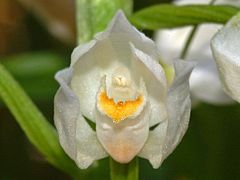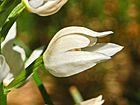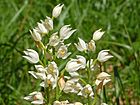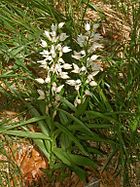- Sword-leaved Helleborine
-
Sword-leaved Helleborine 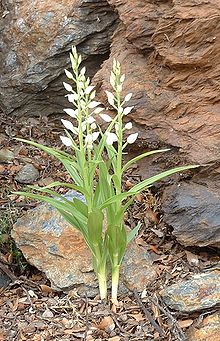
Sword-leaved Helleborine
(Cephalanthera longifolia)Scientific classification Kingdom: Plantae (unranked): Angiosperms (unranked): Monocots Order: Asparagales Family: Orchidaceae Subfamily: Epidendroideae Tribe: Neottieae Subtribe: Limodorinae Genus: Cephalanthera Species: C. longifolia Binomial name Cephalanthera longifolia
(L.) Fritsch 1888Synonyms - Cephalanthera ensifolia (Sw.) Rich.
- Cephalanthera xiphophyllum Reichenb.
- Epipactis ensifolia F.W. Schmidt
- Epipactis longifolia Wettst.
- Serapias helleborine subsp. longifolia L.
- Narrow-leaved Helleborine redirects here; not to be confused with Narrow-lipped Helleborine
Cephalanthera longifolia, common name the Sword-leaved Helleborine or Narrow-leaved Helleborine, is an herbaceous perennial plant with rhizome belonging to the family Orchidaceae.
Contents
Etymology
The genus name Cephalanthera comes from the Greek cephalos (head) and antheros (anther), therefore means with round anthers. The Latin name longifolia means with long leaves .
Description
Cephalanthera longifolia reaches on average 20–60 centimetres (7.9–24 in) of height in typical conditions. This orchid has erect and glabrous multiple stems. The leaves are dark green, long and narrow tapering (hence the common name of Sword-leaved Helleborine). The inflorescence consists of 8-20 bell-shaped flowers of about 1 cm in size. The flowers are white with a yellow-edged labellum and usually they are opened only during the warmest and brightest hours of the day. They can be found in bloom from April to June, depending on location and altitude. The flowers are pollinated by solitary bees and seeds are wind-dispersed.
Distribution
This orchid is present in much of western and southern Europe, in North Africa and in part of Asia up to China. It is common in some parts of its european range, such as southern France and Spain, but endangered particularly in northern areas such as Belgium. In Britain and Ireland is a quite uncommon and declining species, and conservation work is being carried out at a number of sites to safeguard it (see also Galley Down Wood). In 2007 it was listed as a priority species under the UK Biodiversity Action Plan. The charity Plantlife International is leading this work in the UK.
Habitat
Sword-leaved Helleborine usually grow in damp woodland places (mainly oak and beech), forest edges and rocky slopes. These plants prefer calcareous soils and in well exposed places, at an altitude of 0–1,400 metres (0–4,600 ft) above sea level.
Gallery
References
- Pignatti S. - Flora d'Italia (3 voll.) - Edagricole - 1982
- Tutin, T.G. et al. - Flora Europaea, second edition - 1993
- Acta Plantarum
External links
- Den virtuella floran - Distribution
- Plantlife website - species listing
- Naturdata page on Cephalantera longifolia with pictures and information for this species in Portugal
- Biolib
- Cephalanthera-longifolia
This Epidendroideae-related article is a stub. You can help Wikipedia by expanding it.

